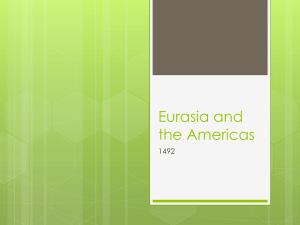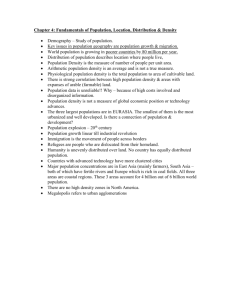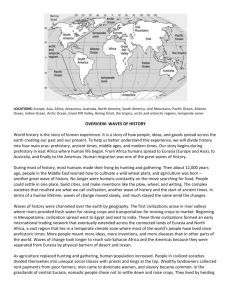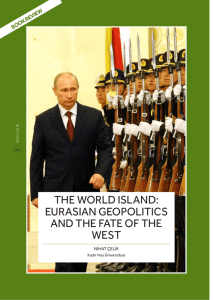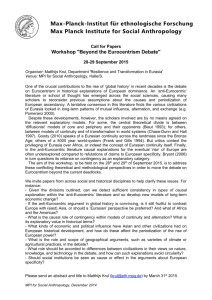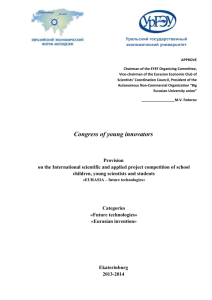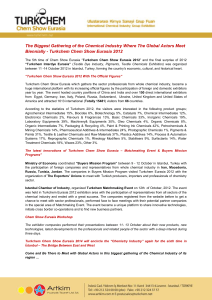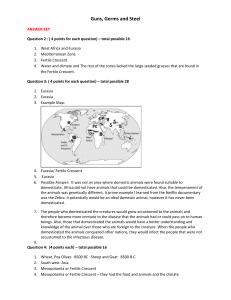Geographical Peculiarities of the Eurasian Region and their
advertisement
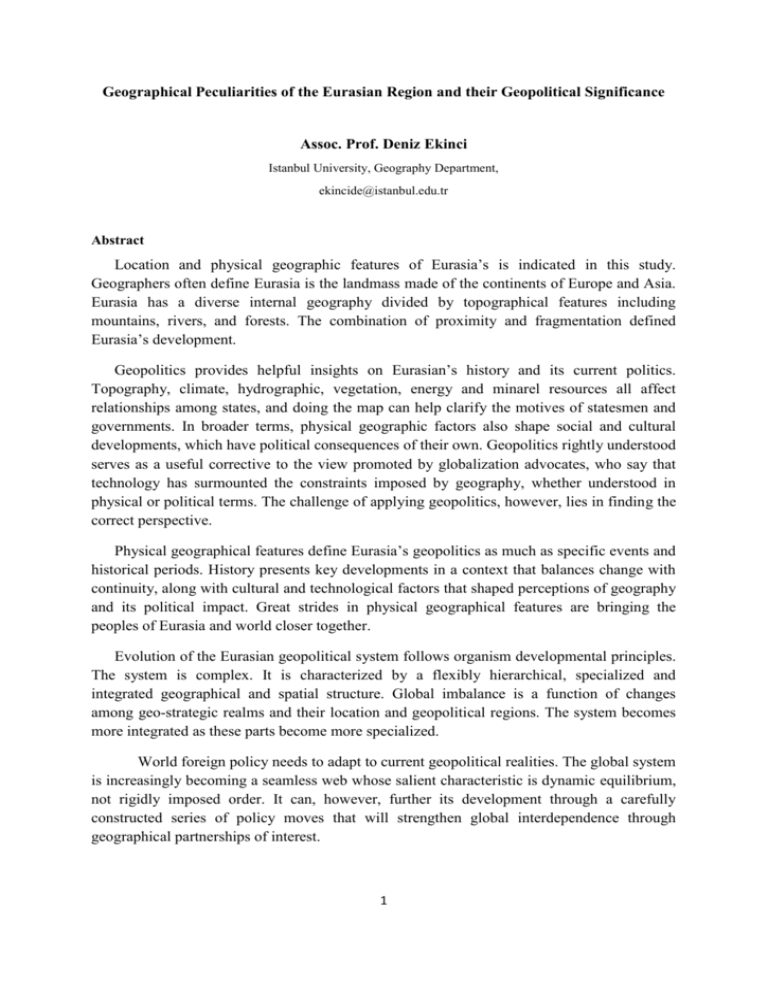
Geographical Peculiarities of the Eurasian Region and their Geopolitical Significance Assoc. Prof. Deniz Ekinci Istanbul University, Geography Department, ekincide@istanbul.edu.tr Abstract Location and physical geographic features of Eurasia’s is indicated in this study. Geographers often define Eurasia is the landmass made of the continents of Europe and Asia. Eurasia has a diverse internal geography divided by topographical features including mountains, rivers, and forests. The combination of proximity and fragmentation defined Eurasia’s development. Geopolitics provides helpful insights on Eurasian’s history and its current politics. Topography, climate, hydrographic, vegetation, energy and minarel resources all affect relationships among states, and doing the map can help clarify the motives of statesmen and governments. In broader terms, physical geographic factors also shape social and cultural developments, which have political consequences of their own. Geopolitics rightly understood serves as a useful corrective to the view promoted by globalization advocates, who say that technology has surmounted the constraints imposed by geography, whether understood in physical or political terms. The challenge of applying geopolitics, however, lies in finding the correct perspective. Physical geographical features define Eurasia’s geopolitics as much as specific events and historical periods. History presents key developments in a context that balances change with continuity, along with cultural and technological factors that shaped perceptions of geography and its political impact. Great strides in physical geographical features are bringing the peoples of Eurasia and world closer together. Evolution of the Eurasian geopolitical system follows organism developmental principles. The system is complex. It is characterized by a flexibly hierarchical, specialized and integrated geographical and spatial structure. Global imbalance is a function of changes among geo-strategic realms and their location and geopolitical regions. The system becomes more integrated as these parts become more specialized. World foreign policy needs to adapt to current geopolitical realities. The global system is increasingly becoming a seamless web whose salient characteristic is dynamic equilibrium, not rigidly imposed order. It can, however, further its development through a carefully constructed series of policy moves that will strengthen global interdependence through geographical partnerships of interest. 1 Geographical Peculiarities of the Eurasian Region Eurasia is consisting of two traditional main lands. One of them is Asia, the other is Europe. Between Europe and Asia borders are distinguished as a geologically arbitrary. However a continent can be larger landmass and surrounding ocean and water. So modern geographers consider it is a single part as a continent called Eurasia. Hence Eurasia is the largest continent of the world. Eurasia is located commonly in the eastern and northern hemispheres and it is placed north of Africa and Australia (Figure 1). Figure 1. Location of Eurasia Eurasia formed 325 to 375 million years ago as a supercontinent and it is covering nearly 52,990,000 km2 that this area is 36.2% of the land region of the Earth. Other say it is about 10.6% of the Earth’s surface. On the north of Eurasia lies the Arctic Ocean, on the west it is bounded by the Atlantic Ocean, on the east and south it is surrounded by the Pacific and the Indian Ocean respectively. Furthermore the term “Eurasia” was sometimes used instead of Caucasus and Central Asia countries. However nowadays it means both Europe and Asia countries. It is state that the Eurasian continent consists of two parts of the world—Europe and Asia; for obvious reasons its geographic dimension can be used in geopolitical contexts as well. Eurasia has superior natural conditions, as it is evident in its topography, climate, geology, and vegetation. Eurasia has got diverse physical features (Figure 2). Eurasian's landform is varied, encompassing mountains, plateaus, basins, plains and hilly areas. Each type of landform presents a particular natural landscape. Eurasia is a mountainous and plateaus continent: mountains, plateaus and hilly areas make up about 60% of its total land area. Many tall and long mountain ranges constitute the framework of the continent's landform. They crisscross one another to form geographical "networks" which, encompassing plateaus, plains and basins of different shapes and sizes, present different landforms. 2 Figure 2. Relief Map of Eurasia It has more land under plains and any other geographic feature. These plains can be broadly divided into the river valleys and the coastal plains. It has some of the greatest river valleys that have been the cradle of civilizations. The major ones are the Yangtze, Huang Ho, Mekong, Irrawaddy, Gang, Brahmaputra, Indus, Danube, Kızılırmak, Tigris and Euphrates, Ob, Yenisey, Lena, etc. to name a few. Taking advantage of its topography and Rivers, Eurasia has built numerous hydroelectric stations on the gorges of Rivers, in a "stair- by-stair" way of development. Eurasia also has some of the world's greatest deserts. It includes both hot and cold deserts. Some of these deserts are the Syrian, Garagum, Oyzlkum, Gobi, Thar, etc. The highest (Mount. Everest) and the lowest point (Dead Sea) on the surface of the earth lie in Eurasia. Along the ranges with elevations of 0 meter and 8848 meters above sea level respectively. Mount Qomolangma of the Himalayas along the Chinese-Nepalese border has a height of 8,848.13 meters above sea level, the tallest peak in the world. That is why the Qinghai-Tibet Plateau is also known as "the roof of the world." It is also home for the mightiest mountain ranges that radiate from the Pamir knot and spreads across Eurasia. The ranges are Kunlun, Tian Shan, Hindukush, Elbruz Mountains, Caucasus, Alps, Balkans, Ararat, Suleiman, Greater Hinggan Mountains, Taihang-WushanXuefeng ranges, and the Highest of them all, the Himalayas. The highest plateau of the world, the Tibetan Plateau lies in Asia. Other prominent plateaus are Anatolian Plateau, Arabian Plateau, Deccan Plateau, Iranian Plateau, Inner Mongolia Plateau, Loess Plateau, the Yunnan-Guizhou Plateau, Qinghai-Tibet Plateau, and middle European Plateaus. 3 It is one of the continents that straddle the greatest number of climatic and vegetation zones. That is to say, Eurasia has all the earth's climatic zones. From north to south, the continent covers polar, cold, temperate, dry, tropical zone (Figure 3). Figure 3. Climatic Zones Map of Eurasia From north to south, the continent covers tundra, taiga, rain forest, temperate forest, grassland, chaparral and desert (Figure 4). Each biome consists of many ecosystems whose communities have adapted to the small differences in climate and the environment inside the biome. Figure 4. Vegetation Zones Map of Eurasia 4 Eurasia is inhabited by almost 4 billion people, more than 71% of the world's population. Eurasia is the most populated continent and the birthplace of many ancient civilizations (Figure 5). Figure 5. Population Density of Eurasia (http://www.larouchepub.com). It has also the most countries in the world. Russia is the largest country in the Eurasia, comprising roughly 1/6th of the world's land mass (Figure 6). Figure 6. Countries of Eurasia 5 Geopolitical Significance of Geographical Peculiarities Eurasian geopolitics represents a complex blending of power and paradox, both stable and instable, with change occurring against an unresolved tension between the direction of economic growth and that of strategic development. Nevertheless Eurasia’s vast geography and its potential are to promote geopolitics significance. It is home to most of the world's politically assertive states and all the historical pretenders to global power. Accounting for 75 percent of the world's population, 60 percent of its output, and 75 percent of its energy resources are in here (Brzezinski,1997). So Eurasia is the axial supercontinent and has a very important geostrategic location. For example; Eurasia was the host of many modern civilizations, based in Mesopotamia, the Indus Valley, and ancient Memphis. Guns, germs and steel are credit Eurasia's dominance in world history. The Silk and Silic Road symbolizes trade and cultural exchange linking Eurasian cultures through history and has been an increasingly popular topic. Over recent decades the idea of a greater Eurasian history has developed with the aim of investigating the genetic, cultural and linguistic relationships between European and Asian cultures of antiquity. Eurasia is home to most of the world's politically assertive and dynamic states. All the historical pretenders to global power originated in Eurasia. The world's most populous aspirants to regional hegemony, China and India, are in Eurasia. After the United States, the next six largest economies and military spenders are there, as are all but one of the world's overt nuclear powers, and all but one of the covert ones. A power that dominated Eurasia would exercise decisive influence over two of the world's three most economically productive regions, Western Europe and East Asia (www.foreignaffairs.com). Eurasia is a continent very much endowed with rich natural resources, such as coal, iron, oil, natural gas, gold, minerals. All of that helped to make both the countries of region and whole world an industrial power. With bountiful and diverse minerals, Eurasia, the world's largest continent in land area had a significant percentage of the world's mineral resources and produced 45 % of the world's total mineral extraction. Mining was the continent's leading industry, and Eurasia was the largest producer of coal, palladium, nickel, aluminum, platinum, potash, gold, copper, bauxite, cobalt, diamond, lead, mica, natural gas, oil, tin, zinc, and many other metals, industrial minerals, and mineral fuels. Petroleum, petroleum products, and natural gas, metals and chemicals were Eurasia's leading export commodities in nowadays. Russia Federation, The Middle East and the Caspian Basin, which have the most important oil reserves and particularly Russia Federation has huge natural gas in the world. Seventy percent of the world natural energy sources are in Eurasia. Eurasia’s vast energy resources could be the world’s answer to overdependence on unreliable Russian or Middle Eastern sources. Eurasia has a distribution and export pipeline network. These networks include a number of pipelines that transport oil to export terminals (Figure 7). Such as Druzhba, Baltic 6 Pipeline System, North-Western Pipeline System, Baku-Tiflis-Ceyhan, Tengiz-Novorossiisk, Baku-Novorossiisk, and Blue Stream (Figure 8). Figure 7. Natural Gas Map a Part of the Eurasia (IEA, 2005). Figure 8. Blue Stream Image (www.offshore-technology.com) As seen Eurasia has become ground zero in global energy markets as demand has accelerated to fuel urbanization and transportation, power, petrochemical, and industrial growth. The shift in the locus of global energy demand from mature industrial countries to 7 developing Eurasia is transforming the landscape of global energy markets and geopolitics. The trends are stunning. For example, the International Energy Agency (IEA) forecasts that in the two decades leading up to 2030, China and India combined are likely to account for more than 50% of total world energy demand growth, 60% of world oil demand growth, 20% of natural gas demand growth, and 85% of world coal demand growth (Herberg, 2010). Eurasia’s boom in oil and natural gas demand has increasingly provoked a scramble among regional powers to secure access to and control over future oil and gas supplies, as well as intense competition over control of oil and gas transportation links and transit infrastructure. More transit pipelines will be needed in the future. Oil and gas reserves close to market are being depleted. Because of economies of scale, road or rail transport of oil and gas is extremely expensive. This leaves pipelines as the only viable alternative for transporting significant volumes. There is growing demand for natural gas in the world’s primary energy mix. Many gas markets have been constrained in the past by regulatory and institutional factors (Stevens, 2010). Roughly a decade has passed since countries of this region particularly Russia’s pipeline politics in Eurasia started to receive global attention (Itoh, 2010). Result Eurasia has a special place within the world. There are a lot of ways to think about the Eurasian continent in geopolitical terms. The first one focuses on its European and Asian geographic dimensions in its geopolitical vision of the continent. The Eurasian continent consists of two parts of the world—Europe and Asia; for obvious reasons its geographic dimension can be used in geopolitical contexts as well. Eurasia, the globe’s largest continent, is geopolitically important. According to Brzezinski; “For half a millennium, world affairs were dominated by Eurasian powers and peoples who fought with one another for regional domination and reached out for global power. A power that dominates Eurasia would control two of the world’s three most advanced and economically productive regions. About 75 % of the world’s people live in Eurasia and most of the world’s physical wealth is there as well, both in its enterprises and underneath its soil. Eurasia accounts for about 60 % of the world’s GNP and about three fourth of the world’s known energy resources. All but one of the world’s overt nuclear powers and all but one of the covert ones are located in Eurasia”. Almost every mineral used in industry is found in Eurasian Republics. The region’s oil and gas reserves could be a major contribution to socio-economic development and transition of Eurasia. The Eurasia states have one of the world’s largest oil and gas reserves, which make them very significant to global markets. Energy is one of the most important strategic subjects for countries. A lot of countries are mainly depending on imported energy sources. Eurasia’s geostrategic and geo-economics significance is bound to increase substantially in the coming decades. All actors involved would rather benefit from converting Eurasia from a zone for geopolitical competition and confrontation to a zone of cooperation. 8 Eurasia is poised to become the new strategic center of gravity in international politics. This transformation is momentous in that for most of the modern era the continent subsisted mainly as an arena for Western exploitation and dominance. Over the last decade, since national independence, a number of efforts have been made to simultaneously strengthen the national independence of the Eurasian states while facilitating greater trans-border cooperation. Regional cooperation and integration is the best way to solve the problems of economic development they face. References Brzezınskı, Z., (1997), The Grand Chessboard, Basic Books, New York. Brzezinski, Z., (2007), The Geostrategic Triad: Living with China, Europe, and Russia, Washington, D.C.: The CSIS Press. Clover, C., (1999), “Dreams of the Eurasian Heartland: The Reemergence of Geopolitics,” Foreign Affairs, 78, 2:9-13. Cohen, S. B., (2005), The Eurasian Convergence Zone: Gateway or Shatterbelt?, In Eurasian Geography and Economics, 46, 1:1-22. Cohen, S.B., (2003), Geopolitics of the World System, Rowman and Littlefield, Lanham. Çetin, T , Oğuz, B., (2007), The Reform İn The Turkish Natural Gas Market: A Critical Evaluation, Energy Policy 35, 3856–3867. Edgar Hoffmann, E., (2010), Eurasia between Cultural Studies and Marketing, Journal of Eurasian Studies 1, 119–126. Gleason, A., (2010), Eurasia: What is it? Is it?, Journal of Eurasian Studies 1, 26–32. Greg, H., (2008), Dispersal of Gondwanaland, University of Leeds. Herberg, E.M., ( 2010), Pipeline Politics in Asia: Energy Nationalism and Energy Markets, Pipeline Politics in Asia The Intersection of Demand, Energy Markets, and Supply Routes, nbr special report 23. Herberg, E.M., ( 2010), Pipeline Politics in Asia: Implications for the United States, Pipeline Politics in Asia The Intersection of Demand, Energy Markets, and Supply Routes, nbr special report 23. IEA, 2005. Energy Policies of IEA Countries, Turkey-2005 Review, IEA/OECD Paris, 2005. IEA, 2005. Natural Gas Information 2005, IEA/OECD Paris, 2005. Itoh, S., ( 2010), The Geopolitics of Northeast Asia’s Pipeline Development, Pipeline Politics in Asia The Intersection of Demand, Energy Markets, and Supply Routes, nbr special report 23. Kerr, D., (1995), “The New Eurasianism,” Europe-Asia Studies, 47, 6:977-988. 9 Parker, G. (1985). Western Geopolitical Thought in the Twentieth Century. New York: St. Martin’s Press. Stevens, P., ( 2010), Oil and Gas Pipelines: Prospects and Problems, Pipeline Politics in Asia The Intersection of Demand, Energy Markets, and Supply Routes, nbr special report 23. Vladimer Papava, V., (2010), Eurasıa Versus Central Caucaso-Asıa: On The Geopolıtıcs of Central Caucaso – Asıa, Cıcero Foundatıon Great Debate Paper No. 09/8,www.cicerofoundation.org. Vlad, L.B., Josan, A., Vlasceanu, A., (2010), Actıve Geo-Strategıc Players, Geopolıtıcal Pıvots And The Changıng Balance Of Power In Eurasıa, Revista Româna de Geografie Politica Year XII, 1, 116-125. http://www.avizora.com/atajo/colaboradores http://www.ca-c.org/journal http://www.cacianalyst.org http://www.comw.org/pda/fulltext/9709brzezinski.html http://www.engdahl.oilgeopolitics.net http://en.wikipedia.org/wiki/Eurasia http://europeangeostrategy.ideasoneurope.eu/tag/eurasia http://www.foreignaffairs.com/articles/53392/zbigniew http://hir.harvard.edu http://www.larouchepub.com. http://www.nationsencyclopedia.com/Europe/Russia http://www.offshore-technology.com http://tsarlazar.wordpress.com http://www.worldsecuritynetwork.com/articleImages 10
